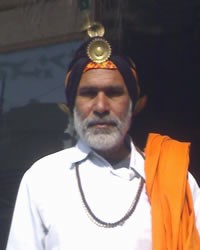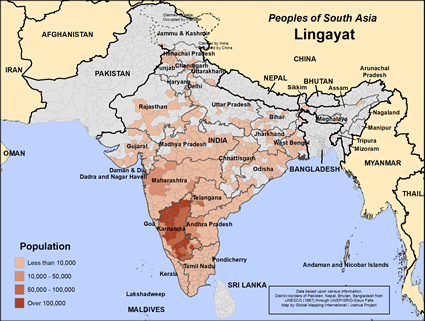The Lingayat people are known for wearing a linga, an object representing a god; in this case, Shiva. They are a numerous group in India, especially in the state of Karnataka.
This group formed in the 12th century by Basava, a philosopher and a social reformer. He taught against the caste system and its regulations. He envisioned a casteless society, though the resulting society eventually began drawing up lines of caste distinctions again, creating their own hierarchy of social status after Basava's death.
Basava consented to the marriage of a Brahmin woman and a man from very low caste. This story reached the ears of King Bijjala who punished the couple by putting out their eyes and dragging them to their deaths behind an elephant. Basava saw this punishment as unacceptable and left Kayla. He moved on to Kudula Sangama where he died in 1167.
They are found primarily in Karnataka, where they comprise a major population. They are also found in significant numbers in Maharashtra and Andhra Pradesh.
The Lingayat are vegetarian and refrain from alcoholic drinks. They are known to be a progressive people and there are people from many walks of life and religious expression to be found among them. Most work in government service, but they are from many occupations, including artisans, cultivators and priests.
They have a series of initiatory rites, including Lingadharane, the bestowing of the linga. This rite is usually performed within the first week of a child's life. From this day forward, the person will wear the stone as an act of worship of the god (Shiva), in a box around their neck. The linga is not seen as a mere representation of god, but rather god himself.
They adore Shiva, but Basava taught that his worshipers should worship him alone rather than numerous gods. Lingayats reject polytheism and the Vedas and follow the teachings of the Vachana sahitya instead.
The Lingayat people need to crave the spiritual food that only Jesus Christ offers. They need his guidance.
Pray that India's Lingayat community will understand their need for a sin-free savior.
Pray for them to have the spiritual hunger it takes to embrace Christ no matter what the cost.
Pray for the Lord to send the right people to the Lingayats as his ambassadors.
Pray for Lingayat devotees of Christ to take his name to others in Karnataka.
Scripture Prayers for the Lingayat in India.
K. S. Singh, ed., India's Communities A-Z, Oxford University Press, USA (June 3, 1999) ISBN-10: 0195633547
http://en.wikipedia.org/wiki/Lingayatism
http://en.wikipedia.org/wiki/Basava
http://en.wikipedia.org/wiki/Vachanas
http://goo.gl
| Profile Source: Joshua Project |











